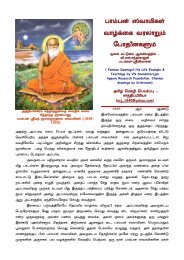MALAYSIAN HINDU PILGRIMAGE: KAVADI ... - Murugan Bhakti
MALAYSIAN HINDU PILGRIMAGE: KAVADI ... - Murugan Bhakti
MALAYSIAN HINDU PILGRIMAGE: KAVADI ... - Murugan Bhakti
You also want an ePaper? Increase the reach of your titles
YUMPU automatically turns print PDFs into web optimized ePapers that Google loves.
spiritual leader of the group, or one of his delegated assistants, helps remove the kavadi and vel-s. Thedevotee is brought out of any residual trance state. The formal aspect of the vow is now complete.The reaction of devotees to the cessation of the trance state is mixed. Some stagger, near to collapse,exhausted by the enormous expenditure of physical and psychic energy, and may require theimmediate support of members of their retinue. A few seem dazed and disoriented, and may requireadditional applications of vibhuti to terminate persistent symptoms of disassociation. Many devoteesdescribe the experience as life transforming and several whom I have interviewed years after thekavadi vows were complete, continue to recollect the yatra in terms of amazement and awe.On the third day after bearing a kavadi, the devotee attend an Itampan puja which formally concludesthe period of temporary renunciation. This acknowledges for some Itampan’s protection, for others thesymbolic role of Itampan as gatekeeper to <strong>Murugan</strong> and his (and their own) spiritual transformation.The devotee is now formally released from the period of renunciation, is “returned” to society andmany resume his/her normal lifestyle. Because this ritual honours a former asura and involves bothanimal sacrifice (a chicken) and the offering of liquor, it is considered non-Agamic and evendisreputable by some orthodox Hindus.CONCLUSIONSIn the earlier section, I noted the centrality of the deity <strong>Murugan</strong> to the process of reformulation ofMalaysian Hinduism and the establishment of a “modern” Hindu identity in multi-ethnic Malaysia. Ialso observed that Thaipusam has become the most widely celebrated Hindu festival in Malaysia.While Thaipusam affords expression to the entire gamut of Malaysian Hinduism from village toAgamic, all worship is permeated with the symbology of <strong>Murugan</strong>, and occurs within the frameworkof the received <strong>Murugan</strong> paradigms.Kavadi worship is central to the celebration of Thaipusam. The individual who decides to bear akavadi undertakes a ritual which is sanctioned by and falls within the understood parameters of theHindu bhakti tradition, in particular as it applies to the worship of <strong>Murugan</strong>. Kavadi worship is an actof pilgrimage, a tirtha-yatra which begins from the periphery of the kaliyuga, a world of chaos andconfusion, and journeys to the centre, the axis mundi, Batu Caves, a recognized pilgrimage centre,where the devotee is exposed to <strong>Murugan</strong> triumphant, a deity possessing his full complement ofpowers. It is a journey which begins with the asceticism of purification, the liminality of detachment,and enters the final phase with the devotee achieving the state of grace (arul) necssary to cross thesuccession of psychic boundaries which lead to the altar in the Cave. Kavadi bearing is a yatra whichemploys the ritual form of worhsip sanctioned by the Itampan myth, and at every level is saturated withsymbology of the myth commemorating <strong>Murugan</strong>’s defeat of Surapadman.At an individual level kavadi worship may be seen as an act of self definition, an inner transformationinvolving public surrender to the deity. At the outer level it is an act of public accomplishment whichdemonstrates both purification and spiritual worthiness. At the group level kavadi worship forms andconsolidates social and network loyalties, whereas at a community level it celebrates a South IndianHindu (and increasingly Malaysian Hindu) ritual within the context of a culturally plural society. It is aritual which simultaneously expresses uniqueness and pride, and underscores Hindu resistance to themultitude of pressures which threaten cultural and religious integrity. Finally, on every level kavadiworship signals allegiance to a wider cultural and political world, to pan-Hindu notions of pilgrimageand worship, and in generic terms to the Hindu heritage which was transplanted with the Indianemigrants, and is now gradually assuming a distinctive Malaysian identity.DOCUMENTATIONBOOKSAckerman, Susan E. and Raymond M. Lee. Heaven in Transition: Non Muslim Religious Innovationand Ethnic Identity in Malaysia. Honolulu: University of Hawaii Press, 1988


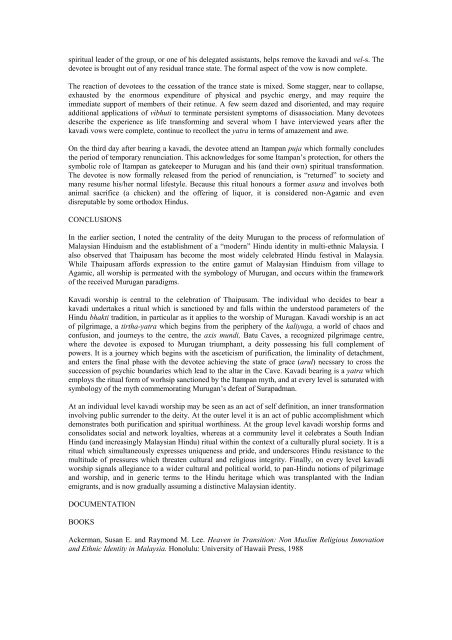
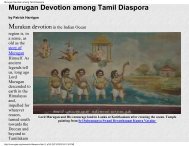
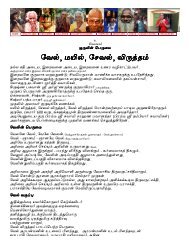
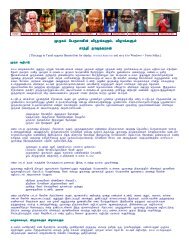
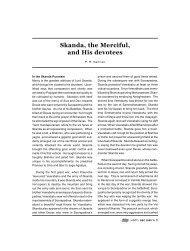
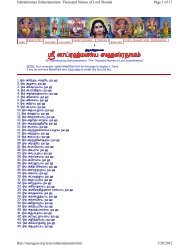
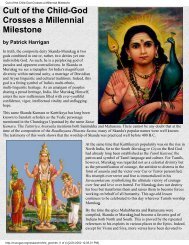
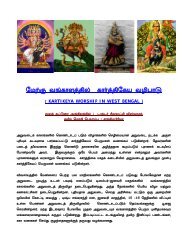
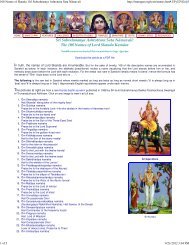
![gHdp k]y Myaj;jpw;F ghj ahj;jpiu fpuhkpa gHf;f Kiwfs;](https://img.yumpu.com/10245948/1/184x260/ghdp-ky-myajjpwf-ghj-ahjjpiu-fpuhkpa-ghff-kiwfs.jpg?quality=85)

